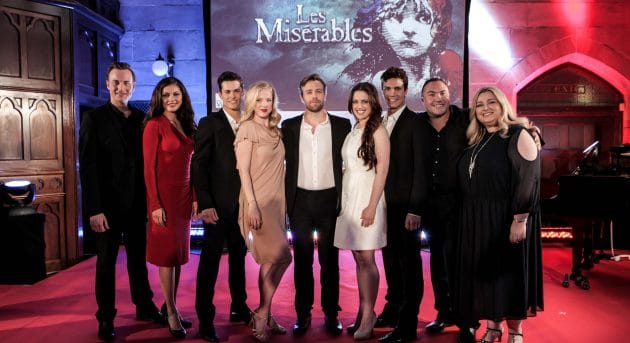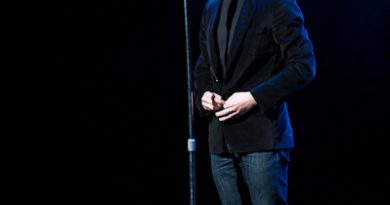Les Miserables: Beyond the Barricade
Related Articles
View latest News, Interviews, Photo Features & Videos from the Australia Tour of Les Miserables.A little over a week ago, on a cold, wet, windy Melbourne Spring day, a long awaited announcement took place: Les Misérables – one of the most successful musicals of all time – confirmed its cast for the official 25th anniversary production, set to open in Melbourne in June 2014. Jan Chandler was there to soak up the atmosphere and excitement…
Gathered in the beautiful Gothic-style hall that is The Chapter House adjoining Melbourne’s St Paul’s Cathedral were a host of media, government ministers (including the Victorian Premier) as well as many who love musical theatre – both performers and audience. Anticipation was high and for good reason – a new generation of musical theatre stars were to be announced and it was a momentous occasion.
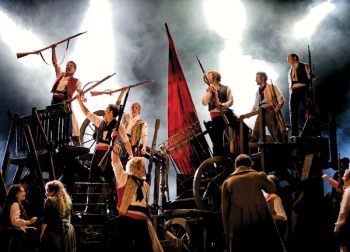
Simon Burke, who first won my heart when he played Marius in the 1987 production, and who openly credited this role as his big break in musical theatre, was the Master of Ceremonies. He was joined by special guest French record producer, singer, songwriter, and composer of Les Misérables, Claude-Michel Schönberg.
The story of how a musical, written by two young Frenchmen – composer Claude-Michel Schönberg and writer Alain Boublil – travelled from an arena in Paris to stages across the world proved to be a fascinating one.
Schönberg and his friend Boublil wrote their musical La Révolution Française in 1973. As Schönberg explained to ABC’s Michael Cathcart, France is not known for its musicals, hence there were no rules for them to break; they just did what they wanted and wrote from instinct. The result, in Schönberg’s words, was that “strange animal … an operatic musical”. It was a success, running for three months in an arena in Paris, “filling a slot between Oliver on Ice and the Circus from Moscow.”
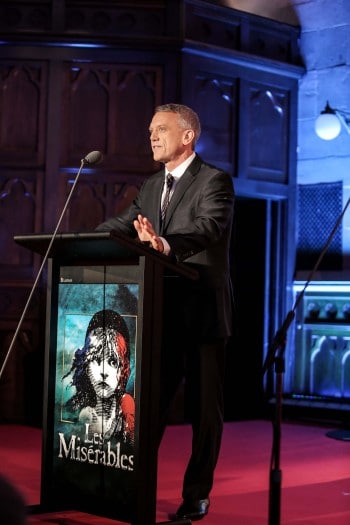
But how was this relatively obscure musical transfromed into the Les Misérables we all know and love? As Schönberg tells it, three years after the original show closed in Paris a young director from Manchester brought Cameron Mackintosh a French concept album of the Paris production, suggesting he listen to it. Describing a French musical as a contradiction in terms, Mackintosh put the record aside. Two weeks later, on a rainy afternoon, with little to do but re-organise his bookshelves, he picked up a record and put it on the record player. He had only listened to two tracks when, as he later told Schönberg, he was struck with the vision of the musical he would create.
Mackintosh visited Alan J Lerner (of My Fair Lady fame) the same afternoon asking him to listen to the recording. Speaking to Michael Cathcart, Schönberg said that Lerner thought that the piece was “beautiful” but told Mackintosh that he didn’t know how to write about real people; “…everything I’ve written has been fantasy … but you must do it.” So Mackintosh began a search for Schönberg and Boublil.
When the three first came together in February 1982, they agreed that the major problem was how to adapt a French musical, especially one based on the work of a national hero, nineteenth century French author Victor Hugo, for an international audience who couldn’t be expected to know the original as the French did. Mackintosh insisted that Schönberg and Boublil do the re-writing, telling them that what they were doing was so special that this was the only way to ensure that their particular style, sound and spirit could be retained. He would introduce them to people who were experts in musical theatre – James Fenton, Trevor Nunn, John Caird, Herbert Kretzmer – but they must do the re-writing themselves.
As Schönberg told Cathcart: “He could have bought the rights … very bold for him to ask two young people who didn’t know anything about musical theatre to re-write a piece of musical theatre.”
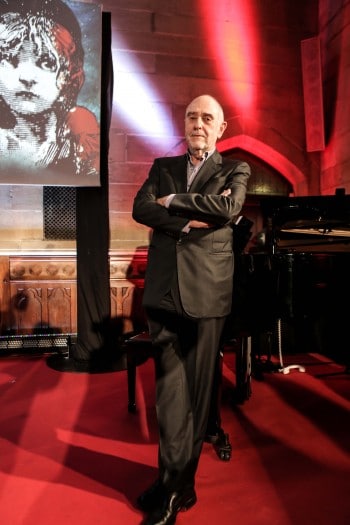
The original production of Les Misérables opened at the Barbican Theatre in London on 8 October 1985. Schönberg remembers it as a disaster; critics canned the show as being “a trivial version of a European work of art”, “gibberish”, that had “stupid lyrics with poor rhyme”. He remembers that the traditional lunch following opening night was like being at a funeral; everyone was “so sad” and believed that it was the end. Mackintosh decided to “get all the bad news out of the way” and rang the Barbican box office to find out how badly the reviews had affected ticket sales. He had difficulty getting through. When he finally spoke to the director of box office he was told that they’d sold a record-breaking 5,000 tickets that morning. Word of mouth had won out over the critics and soon even they would come, becoming as enthusiastic as the audiences.
A two month run at the Barbican was sold out and Mackintosh took the risk of transferring the production to the Palace Theatre in the West End. What a risk! They stayed there for eighteen years and only had to move because the theatre was so old that it needed to be rebuilt! Les Misérables then transferred to the Queen’s Theatre where, as Mackintosh says, “the production has gained in intimacy and power, and still has standing ovations after nearly every performance.”
Schönberg remembers his pleasure at the talent that emerged from the auditions for the first Australian production in January 1987, “we found wonderful people who were going to become important stars in Australia, Simon Burke, Anthony Warlow. There was this wonderful Debbie Byrne, Normie Rowe as Jean Valjean, maybe the best Javert in the world, Philip Quast, and Marina Prior … that’s when we discovered the huge talent that you have in Australia”.
Schönberg’s commitment to Les Misérables extends to the making of the recent Oscar winning film. In his conversation with Cathcart he explained that he was much more deeply involved than he had anticipated; “from the first second until the very last moment … because the script of the movie is the score … so each time there was an edit or change of scene I had to re-write the music because I wanted to save the arc of the score; the same way I’m trying to save arc of the show on stage.” He was not surprised to find that the two principals were Australian (Hugh Jackman and Russell Crowe). He told the audience at the launch, they sang “beautifully … it’s part of the soul of the country, it’s part of the culture of the country”.
Producer Sir Cameron Mackintosh, speaking via video at the launch, is equally enthusiastic and expressed his delight in “having found an extraordinary new group of talent” for the 25th anniversary production. As he explained, this new production will be very different from the original. The famous revolving stage has gone and in its place the paintings of Victor Hugo are used as the basis for the telling of his great story. Mackintosh credits his designer Matt Kinley with coming up with this “brilliant idea”.
“[Kinley] and his wonderful team have created a completely new way of looking at Les Misérables. If anything it has an even more gritty integrity than the original. It has made the show, everywhere we’ve played it, seem like it’s just been written today.”
This time the critics are in total agreement. The new production has received enthusiastic responses everywhere it has played – the US, France, Spain and the UK – and soon Australian audiences will be able to judge for themselves.
The purpose of the launch was to announce the new Australian cast. In case you don’t already know, they are: Simon Gleeson (Jean Valjean); Hadden Tee (Javert); Patrice Tipoki (Fantine), Lara Mulcahy (Madame Thenardier); Trevor Ashley (Mounsieur Thenardier), Kerrie Anne Greenland (Eponine); Emily Landgridge (Cosette); Chris Durling (Enjolras) and Euan Doidge (Marius). They will be joined by an ensemble of twenty-four, with the child roles of Little Cosette, Young Eponine, and Gavroche to be cast in early 2014.
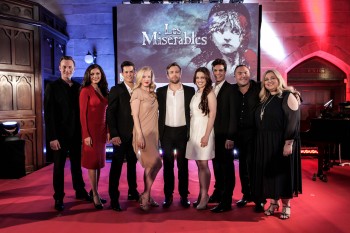
After the announcements the cast members, joined by ensemble singers and accompanied by musical director Geoffrey Castles on piano, treated the audience to a medley of some of the best loved songs from Les Misérables including ‘I Dreamed a Dream’, ‘Stars’, ‘On My Own’ and ‘One Day More’. Undoubtedly the highlight of the event was when the composer himself sat at the piano to accompany Simon Gleeson singing the emotional ‘Bring Him Home’. The performance packed a real punch with the audience left emotionally drained, some even in tears.
The very best musical theatre takes the audience on an dramatic, emotional journey, with laughter and tears and leaves them wanting more. This new production promises to do just this for audiences old and new.
Tickets are now on sale: www.ticketek.com.au/lesmis or Phone: 1300 795 012
Related Articles
View latest News, Interviews, Photo Features & Videos from the Australia Tour of Les Miserables.

